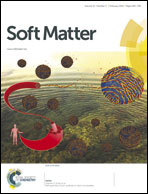Application of solubility parameters in a d-sorbitol-based organogel in binary organic mixtures†
Abstract
The gelation behaviour of a low molecular weight gelator 2,4-(3,4-dichlorobenzylidene)-D-sorbitol (DCBS) in a binary solvent system has been studied. DCBS was soluble in pure ethanol and insoluble in pure methylcyclohexane. However, DCBS formed opaque gels in ethanol–methylcyclohexane mixtures when the methylcyclohexane content varied from 50% to 80%. Within this range, an increase in the amount of methylcyclohexane reduced the gelation time and also caused the minimum gelation concentration to decrease. Scanning electron microscopy showed that the three-dimensional network structures of the xerogels became denser (from tape-like structures to uniform fibres) when the methylcyclohexane content increased from 40% to 80%. The precipitates that formed in 90% and 100% methylcyclohexane had rod-like structures. X-ray diffraction of the xerogels showed that in the gel state, the DCBS gelator had lamellar packing, which was different from the structure of the precipitate. Fourier transform infrared spectroscopy of the xerogels showed that H-bonding was a driving force for the self-aggregation of the DCBS and it was enhanced as the methylcyclohexane content increased. To estimate the gelator–solvent interactions, the Flory–Huggins parameter was calculated for the DCBS gelator in the binary mixed solvent systems. Based on the values of the Flory–Huggins parameter, the gelation behaviours could be grouped into four domains (solution, partial gel, gel and precipitation). This is a simple method to predict the gelation behaviour of DCBS in some mixed solvents.


 Please wait while we load your content...
Please wait while we load your content...